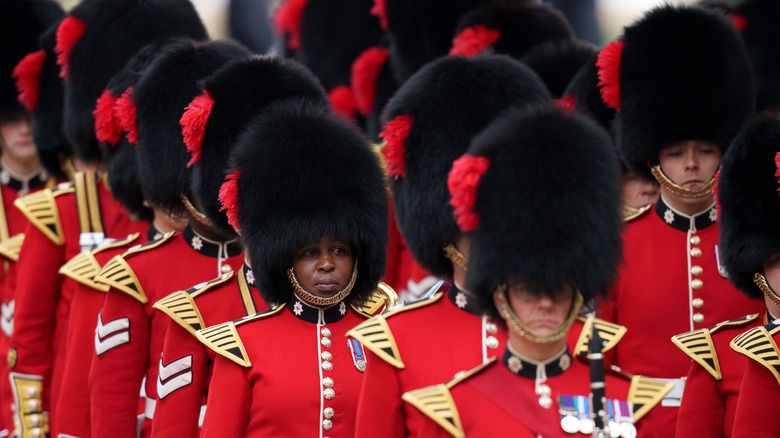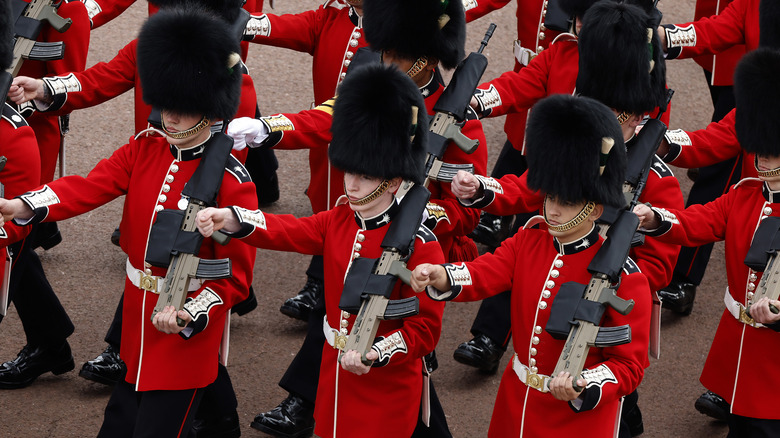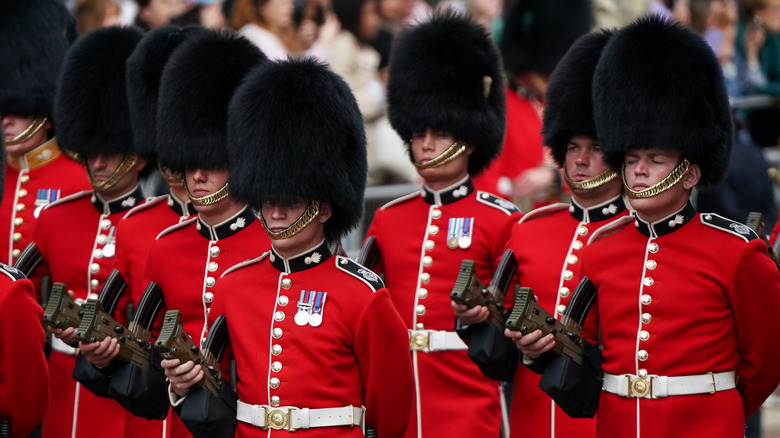One Of The Most Important Parts Of Royal Guard Training Is One You May Not Expect
The British royal guardsmen, sometimes called the king or queen's guard, are an iconic symbol of England. In their tall, black bearskin hats and bright red-colored tunics, this elite force is often seen guarding royal residences like Buckingham Palace or the Tower of London. The royal guard was formed while Henry VII reigned over England, and in the five centuries since then, they've dutifully served a number of monarchs as bodyguards or as a personal security force for the sovereign. They also served in major overseas conflicts, and members of the royal guard stood watch over Queen Elizabeth's coffin before her funeral while it lay in state for four days at Westminster Hall in London, as Household Division explains.
Today, the so-called changing of the royal guard — when one regimen of the soldiers is relieved by another — is a popular tourist attraction at the Tower of London, as well as Buckingham and St. James Palaces, among other places. Thousands of tourists gather each year to snap a photo of the proceeding, like a time capsule from British history. Famously, these guards who must serve in the British military prior to their royal guard tour of duty, must stand stock still, not speak, and march in unison, according to Reader's Digest. For these reasons and more, there's a good deal to learn when a British soldier joins the royal guard. Given the tasks that the regiment is typically known to perform, though, one aspect of their training regimen could perhaps be a surprise for many.
Royal guardsmen are real soldiers
As the British Army website points out, despite the royal guard's distinctive uniforms — which seem perhaps over-the-top to some by today's standards, as well as their highly traditional customs — they are, in fact, real soldiers and are trained to fight, serving in the British military before they joined the regiment. They also only dress like they do while on royal guard duty. One might assume that standing stock still and not speaking as the royal guard are known to do is quite easy, but with shifts running 24 hours a day at royal residences like Buckingham Palace, maintaining that composure is not as simple as it might seem — they do occasionally crack a smile, and some even take offense when tourists imitate their distinctive march poorly, according to Reader's Digest.
While on duty, guards typically alternate two hours standing watch with a four-hour break in between, as Changing-Guard explains. Besides their service in the British military, royal guardsmen such as those that guard the Tower of London and who stood vigil alongside Queen Elizabeth's casket must also pass a test, called the British Army Recruit Battery (BARB), just like any other British army recruit. The BARB test must assess a prospective candidate's ability to reason and think logically, among other cognitive standards, per the University of Cambridge website. Given the role they fulfill and the uniform they're expected to wear, a candidate for the royal guard will be tall — and even taller once they put that hat on.
Heatstroke can also sometimes be an issue
Some fail to realize that though they're most often silent, royal guardsmen are allowed to speak or shout a command should someone come too close, fail to follow instructions, or should a passer-by act aggressively, as Reader's Digest goes on to note. Royal guards are even known to sometimes pass out from standing in one spot for too long, per the Evening Standard. The health risks associated with standing in one place for too long which can sometimes bring on a fainting spell are not the only dangers royal guardsmen face: They must also learn to endure the heat — yes, even in England. Though the weather in the U.K. is not normally thought of as hot, extreme heat waves have grown more common, based on The New York Times reporting.
Changing climate aside, standing stock still in the sunlight for hours on end carries risks all on its own, for which a royal guardsmen recruit must be ready, via the British Army website. In summer months, the polish on the boots of royal guardsmen is even known to melt. As Captain of the Tower of London Guard, Ryan Robinson said (via Army), "It's tough and hard work to keep your concentration when it's hot. The heat debilitates you very, very quickly." You dehydrate fast, Robinson adds, and that affects a guardsman's ability to function, concentrate, and make decisions. Notably, those bearskin hats which some might assume would be hot actually help protect the guardsmen's eyes from glare and are in fact cooler than you might imagine.


